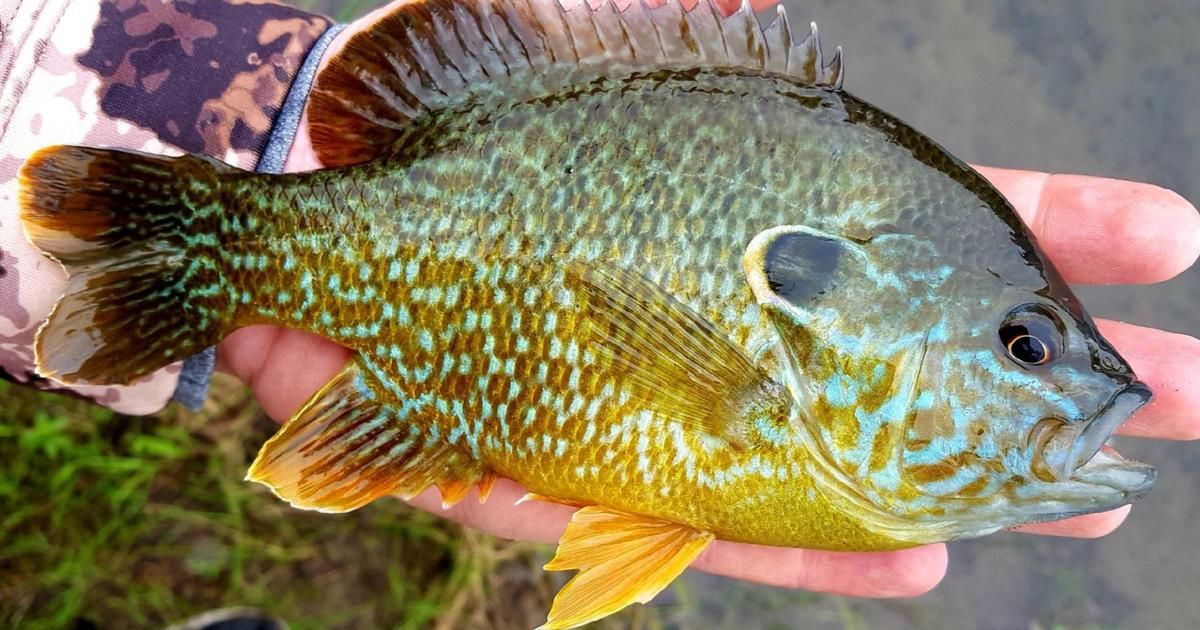Primary Spawn: Late May through July (peak: mid-June to early July) when water temperatures reach 68-75°F; optimal spawning occurs at 70-73°F; spawn timing typically 1-2 weeks after bluegill spawn; among the later spawning sunfish species; spawn may extend into August in northern areas
Spawning Habitat: Shallow protected areas in 1-4 feet of clear water with visibility to bottom; prefer sand, gravel, or fine rubble bottom; clear water essential—pumpkinseed less likely to spawn in turbid conditions than bluegill; protected bays, coves, and shoreline areas with minimal wave action; areas with nearby vegetation for fry cover; will use same areas as bluegill but prefer clearer water with harder substrate
Reproductive Behavior: Pre-spawn (May-early June): As water temperatures reach 60-65°F, pumpkinseed move from deeper areas to shallow spawning grounds; males arrive first and begin selecting nest sites; females stage in nearby deeper water (6-12 feet) feeding heavily; excellent pre-spawn fishing period
Nest Building: Male selects site in shallow, clear area with sand or gravel bottom; fans out circular depression 8-12 inches in diameter using powerful tail sweeps; clears debris and silt exposing clean substrate; nest smaller and shallower than bluegill nests but similarly constructed; construction takes 1-2 days; males become increasingly territorial as nest completion approaches; nests often constructed in loose colonies with multiple males nesting in proximity (3-10 feet apart) but less densely packed than bluegill colonies
Courtship and Spawning: Male develops intense breeding coloration—brilliant orange-red belly, bright ear flap spot, enhanced facial markings; female approaches nest when ready; male performs elaborate courtship display including circling, fin spreading, body tilting, and color intensification; female settles onto nest and deposits 1,500-3,000 eggs in clusters (fewer eggs than similar-sized bluegill); male immediately fertilizes eggs; spawning act occurs in multiple episodes over several hours; female may spawn with single male or visit multiple nests; larger, older females produce more eggs but clutch sizes generally smaller than bluegill
Post-Spawn Male Behavior: Male remains on nest providing intensive parental care; continuously fans eggs with tail and pectoral fins maintaining oxygen and preventing silt accumulation; guards nest with extreme aggression attacking any intruders including much larger fish, other sunfish, crayfish, insects; readily strikes lures and baits—makes pumpkinseed easy to catch during spawn; does not feed during nest-guarding period of 10-14 days (longer than bluegill); loses significant body condition during guard period; fans eggs for 3-5 days until hatching (temperature dependent); continues guarding fry for additional 7-10 days after hatching—longer guard period than most sunfish; fry form tight black school hovering near nest or hiding in nearby vegetation; male protects fry until they disperse into vegetation
Post-Spawn Female Behavior: Females leave nest area immediately after spawning; move to nearby deeper water (6-12 feet) to recover; resume feeding within days; gradually return to normal summer patterns around vegetation and structure; may spawn multiple times if conditions permit
Egg and Fry Development: Eggs hatch in 3-5 days depending on water temperature (faster in warmer water); newly hatched fry are 2-3mm long with attached yolk sac; fry remain in nest depression feeding on yolk sac for 4-6 days; become free-swimming after yolk absorption; initially form tight school under male protection; after male abandons, fry disperse into dense vegetation (lily pads, submerged weeds) for cover; feed on microscopic zooplankton initially; at 1/2 inch begin eating small insect larvae; at 1 inch start consuming small snails and larger insects; steady growth first year; males reach sexual maturity at 2-3 years (4-6 inches); females mature at 3-4 years (5-7 inches)—slower maturity than bluegill
Nest Site Fidelity: Males often return to same general spawning areas in subsequent years; successful colony sites may be used repeatedly for decades; pumpkinseed show strong site fidelity
Multiple Spawning: Individual pumpkinseed may spawn 1-2 times in a season if conditions remain favorable and initial nest is successful; extended spawning period (6-8 weeks) increases recruitment success for population
Spawning Behavior Variations: In very clear water, males may spawn at slightly greater depths (4-6 feet) than typical; water clarity is critical—pumpkinseed less likely to spawn successfully in turbid water than bluegill

